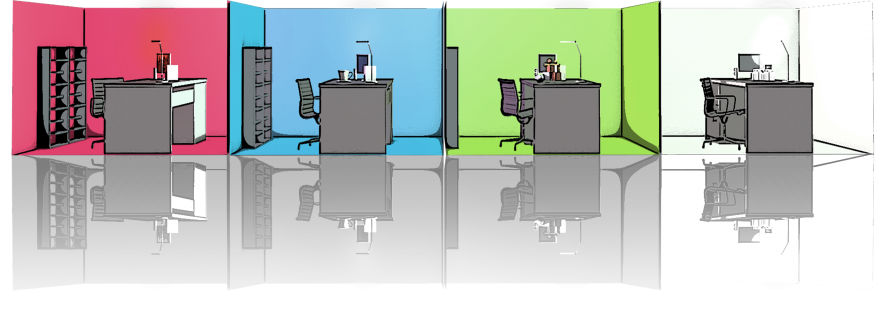Tint your performance
White walls, grey desks, black monitors and dark blue carpets - If that’s the description of your workplace you should prick up your ears - and open your eyes! How about tinting your room and equally “tint” your working performance to reach higher levels?
Colors are ubiquitous in our daily lives and naturally affect us in our working places. These environmental surroundings influence our mood, emotions, and cognitive performance. Shouldn’t we be aware of this fact and shouldn’t we take that into account? Colors might produce attentional processes or associations in your mind, which are able to influence your behavior. Seeing a red mark in an exam probably won’t lead you to positive feelings. Moreover seeing a green plant in front of the window can lead your mind to take a break and unwind. That’s no accident. Colors affect us everywhere we go and most importantly at our working place. How can we use colors to enhance our performance at work?
Red seems to have a big impact in our lives. We have learned that the color red is most commonly used to warn us or give us some sort of immediate attention. It warns us against making a mistake or protects us from „false behavior“ like crossing the street unconsciously while seeing a red traffic light. A group of researchers showed that in achievement contexts like exams, this association can lead us to worse performance because of our fear of failure. The red cover of an IQ-test impaired the performance in the same test compared to a group with blue covers. The very same test printed on either red or blue paper impacts your performance: your results on the red paper probably won’t be as good as on the blue one. In contrast the researchers Kwallek and Lewis and their colleagues showed that in a red-colored office without the pressure of a test situation, the ability of high demanding or detailed tasks improved. A really exceptional aspect is, that people, especially women, in this study not only made the least errors in a proofreading task in a red office but made the most errors in a white office although that seems to be the usual office appearance. An important hint is that strong saturated colors like red can distract you and your attention which might have the opposite effect on your performance and should always be taken into account. Females in this study especially reported more tension and less vigor in the work sitting in the red room. The emotional effects of color shouldn’t be underestimated.
Watching the blue sky lying in the green grass my have a pretty positive effect on our mood. That is certainly not only because of the colors but because of other pleasant environmental aspects. Nevertheless, the researchers mentioned above proposed that blue might have a calming effect and can slow down your excitement in the exam situation. Apart from that, this calming effect could negatively influence you in highly complicated tasks where you might need some more attention. Nevertheless, Lichtenfeld and colleagues showed that blue but especially green colors are able to enhance your creativity. If you work as a designer or in some sort of creative field, a green poster, office wall or screen saver might help you to reach that goal a little easier. There is also evidence that these colors produce additional „good mood“ and who doesn’t want that?
In conclusion, there is some discussion between researchers which color might have which effect. A red color which isn’t distracting to you seems to focus your attention in difficult tasks but impair your performance in test situations. Blue is helpful in demanding situations to lift up your mood and reduce stress but might reduce your attention. And green color can increase your creativity for better results. But keep in mind: You should always be aware that people react differently to colors and the affects of colors may vary between persons. So give it a try and find the best solution for yourself being aware that even a plane white office might have negative effects to you. Colors may have more influence on our daily tasks than we think. Here are some possibilities to tint your work space, increase your performance, lift up your mood and make your life a little more colorful – give it a chance!
References:
Elliot, A. J., Maier, M. A., Moller, A. C., Friedman, R., & Meinhardt, J. (2007). Color and psychological functioning: the effect of red on performance attainment. Journal of experimental psychology: General, 136(1), 154.
Kwallek, N., Lewis, C. M., Lin-Hsiao, J. W., & Woodson, H. (1996). Effects of nine monochromatic office interior colors on clerical tasks and worker mood. Color Research and Application, 21, 448–458.
Lichtenfeld, S., Elliot, A. J., Maier, M. A., & Pekrun, R. (2012). Fertile green green facilitates creative performance. Personality and Social Psychology Bulletin, 38(6), 784-797.


0 Comments